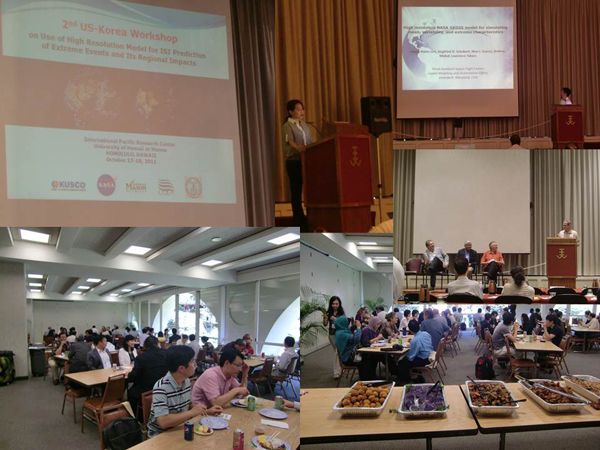
KUSCO supported the “U.S. – Korea Workshop on Use of High Resolution Model for ISI Prediction of Extreme Events and Its Regional Impacts” on 17-18 October 2011, University of Hawaii at Manoa, Honolulu, HI.
The purpose of the workshop was to develop a collaborative research project between U.S. and Korean scientists in the area of dynamical ISI prediction. The workshop took place from 17-18 October 2011 in University of Hawaii, Honolulu, HI, hosted by Univ. of Hawaii/International Pacific Research Center (IPRC). More than 24 climate scientists from 12 institutes/universities of two countries including 5 local early career Korean scientists were invited.
To use of high-resolution model for intraseasonal to interannual (ISI) prediction which is a topic of great interest, in particular, among many U.S. and Korea scientists. Several centers in the U.S. – COLA, GMU, IPRC, NASA, NCEP/NOAA – are conducting research on dynamical ISI prediction using high-resolution models to advance the regional-scale climate prediction and projections of extreme weather events and their impacts on regional scale. Recently, Korea has established two centers to facilitate the research capability on this area. One is the Next Generation Model Development Center aimed at developing a high-resolution model for advanced real-time regional prediction. The other is the Asia-Pacific Economic Cooperation Climate Center (APCC) aimed at producing produces real-time operational climate prediction information from the multi-model ensemble (MME) system consists of the forecast outputs from 15 institutions of 8 countries.
The U.S.-Korea workshop brought together leading scientists from U.S. and Korea to rigorously assess the current status of high-resolution modeling and ISI prediction in U.S. and Korea and to develop a visionary strategy whose goal is to enable and accelerate collaborative activities in this field. Throughout these comprehensive discussions, a realistic roadmap of how these collaborative activities can be sustained as a long-term continuing effort for mutual international benefit, in particular for young scientists, was developed.
The international organizing committee invited not only local Korean climate scientists (Univ. of Hawaii) but also early career Korean scientists from U.S. via “Young Scientist Travel Grant” program for the workshop. They conducted the oral presentations and were encouraged to play an important role in the discussion and future planning. In particular, there has been lots of two-way traffic between U.S. and Korea because most of Korean scientists, especially younger ones, have worked in the U.S. for some part of their career. They have a great deal of knowledge of the US system and have many contacts in the US. This makes collaboration very natural and likely to be successful.
New collaborative activities and long-term strategies emerged from this workshop. These international efforts will contribute to the enhancement and improvement of climate prediction modeling for the mutual benefits of the U.S. and Korea.
